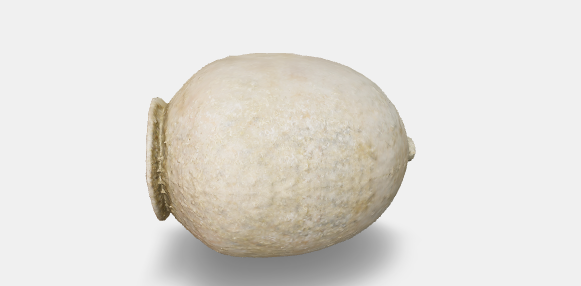The artefact is entirely colonized by fouling organisms, consisting almost exclusively of sedentary Polychaeta belonging to various genera. There are small calcareous tubes of various dimensions, of an elongated or coiled up shape and different ornaments on the surface. There is a lesser presence of incomplete remains of Anthozoa and flattened colonies of Bryozoa. The rather homogenous patterns of biological growth indicate that the artefact was exposed to marine agents on its entire surface and that this process was somewhat continuous.

A dolium is a large and particular container with a globular shape, used in the holds of Roman cargo ships for transporting wine during a limited period of time (from the beginning of the Augustan age till the first half of the I century A.D). In fact, all the shipwrecks found so far in the Mediterranean come from this time span.
The primary origin of this particular transport container is probably in the area of Minturnae (close to today’s Minturno, in south Latium, province of Latina), known in ancient times for its notable winemaking. Many of the stamps found on dolia can be in fact referred to the local gens Pirania who were involved winemaking. The analysis of clays, as in the case of the specimen found in the sea of La Maddalena in Sardinia, seem to be attributable to the city as well.
The majority of underwater discoveries of shipwrecks with dolia indicate the most popular routes towards Gaul and the Iberian Peninsula, known for their excellent wine production. Therefore, it can be assumed that these large containers were used both in outward and return shipments, providing imported wine to the Italian Peninsula. This is also confirmed by the presence of amphorae of Gallic and Iberian production in the holds . These containers were easier to unload, and therefore, easily replaceable.
The discovery of a dolium in the sea in front of Egnatia opens a new and interesting prospective on the routes of cargo ships that transported wine between the I century B.C. and the I century A.D.
The fact that dolia were preferred to amphoras in this time span may be a confirmation of a commercialisation of viticulture products in greater quantities and lesser quality, a phenomenon that seems to fit well in the socio-economic evolution of the Mediterranean basin during the Augustan age.
Gianfrotta P.A. 1998, Nuovi rinvenimenti subacquei per lo studio di alcuni aspetti del commercio marittimo del vino (I sec. a.C. – I sec. d.C.), in El vi a l’antiguitat, Actes II. Colloqui internacional d’arqueologia romana, Badalona, pp. 105-112.
Sciallano M., Marlier S. 2008, L’èpave à dolia de l’ìle de la Giraglia (Haute Corse), in Archaeonautica, 15, pp. 113-151.



